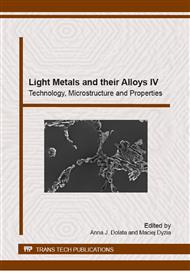p.71
p.77
p.83
p.89
p.99
p.105
p.115
p.125
p.131
The Mechanisms of Cavitation Erosion of the Elektron21 Magnesium Alloy
Abstract:
Magnesium and its alloys may be applied as cathodic protection for steel constructions. As the protectors work in water environment, one of the main degradation factors is cavitation erosion. The paper presents results of research on the cavitation erosion of magnesium casting alloy – Elektron 21. The cavitation erosion tests were performed using vibratory apparatus. After the cavitation tests eroded surface and the cross-sections of the specimens were observed by means of scanning electron microscopy. Elektron 21 did not exhibit distinct incubation period of cavitation erosion. The cavitation pits are observed mainly in the α-Mg solid solution grains and on the interfaces between intermetallic phases and the α-Mg. On the other hand, the Mg3(Nd, Gd) eutectic phases are more resistant to cavitation erosion than α-Mg. They are protecting the solid solution from degradation. However, due to their high hardness they undergo cracking and detachment of from the surface. After longer times of cavitation tests, cracks begin to propagate into the material, which leads to crushing of bigger parts of the material.
Info:
Periodical:
Pages:
99-104
Citation:
Online since:
April 2015
Keywords:
Price:
Сopyright:
© 2015 Trans Tech Publications Ltd. All Rights Reserved
Share:
Citation:


